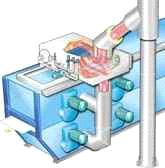Offset Printing
Goss Ecobox heatset dryer enhancement delivers immediate environmental and economic benefits

Monday 04. May 2009 - Technology recovers heat from exhaust air to reduce energy consumption in printing facilities
The Goss Ecobox thermal energy recovery system enhancement is now available worldwide, extending the environmental advantages of Goss heatset dryers and allowing printing facilities to reduce energy consumption significantly.
Water circulating through the system is heated by exhaust air from the dryer. The heated water can then be used directly or converted to replace or supplement the energy required for heating, air conditioning and other systems within the facility.
“The Ecobox enhancement is simple to install and delivers immediate environmental and economic benefits,” explains Graham Trevett, Goss International sales vice president in the United States. “Printers that install the device can cut energy requirements considerably, reducing their costs and their carbon footprint at the same time.”
Trevett says, on average, energy generated offsets the cost of an Ecobox system installation in 18 months in typical heatset web printing operations. The return on investment is even faster with larger dryers.
The Ecobox enhancement is compatible with dryers equipped with integrated afterburners, including Goss Ecocool T and Ecotherm models. The compact device mounts on the dryer. No additional floor space is required, and press downtime for installation is minimal. The default temperature of the heated water exiting the system is 203 degrees Fahrenheit (95 degrees Celsius) and can be adjusted. Excess or unneeded heat from the dryer can be exhausted directly through a bypass valve.
Trevett says that Goss International has installed Ecobox systems throughout Europe. Printers there have used the recovered energy for heating, air conditioning and a variety of other purposes ranging from hot water for the building’s plumbing system to heating parking lots for snow and ice removal. Some have also sold the energy to nearby facilities. “With the increased emphasis on greener operations, we are now seeing a significant interest in this technology in North America,” Trevett adds.
